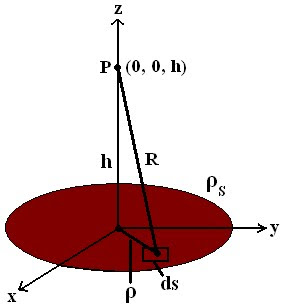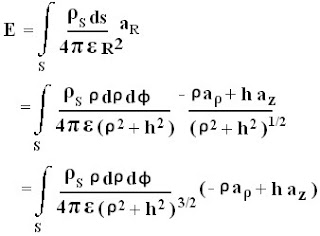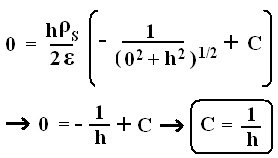Electric Field Intensity Due To a Circular Disk Charge - Field Theory.

- Consider a circular disc of radius ‘a’ which carries a uniform surface charge density ρs , C /m2.
- Say the disk lies on x-y plane (or z = 0 plane) with its axis along the z axis as shown in the figure.
- We need to find out electric field (E) due to a circular disk at a point P (0, 0, h) on the z axis (z > 0).
- Electric field intensity (E) at a point due to any surface charge (ρs) is given as:

- Consider the triangle shown in figure(Since it’s a disc, the varying terms are radius ρ and angle φ)
As per the vector law of addition,
ρ aρ + R = h az → R = - ρ aρ + h az
| R | = (ρ2 + h2)1/2
aR = R / | R |
aR = - ρ aρ + h az / (ρ2 + h2)1/2
Substituting all these values in the above equations, the electric field intensity E becomes
- Contribution along aρ due to symmetry adds up to zero.
- Therefore the final electric field intensity at point (0, 0, h) has only z component.
- As a → 0, the electric field intensity (E) also tends to zero i.e. E → 0
- Hence electric field intensity (E) at point (0, 0, h) is given as:

ALSO READ:
- Introduction To Electrostatics.
- Coulomb's law.
- Electric Field Intensity (E).
- Electric Lines Of Forces /Streamlines / Electric Flux (ψ) .
- Electric Flux Density (D).
- Electric Field Intensity Due To a Finite and Infinite Line Charge.
- Electric Field Intensity Due To a Infinite Sheet Charge.
- Electric Field Intensity Due To a Circular Ring Charge.
- Electric Field Intensity Due To a Circular Disk Charge.
- Numericals / Solved Examples - Electric Force and Field Intensity.
- Numericals / Solved Examples - Electric Field Intensity - Line, Surface and Mixed Charge Configuration.
- Short Notes/FAQ's
Your suggestions and comments are welcome in this section. If you want to share something or if you have some stuff of your own, please do post them in the comments section.






It is not in agreement with ISAT prescribed Formula for the same in the solutions
ReplyDelete